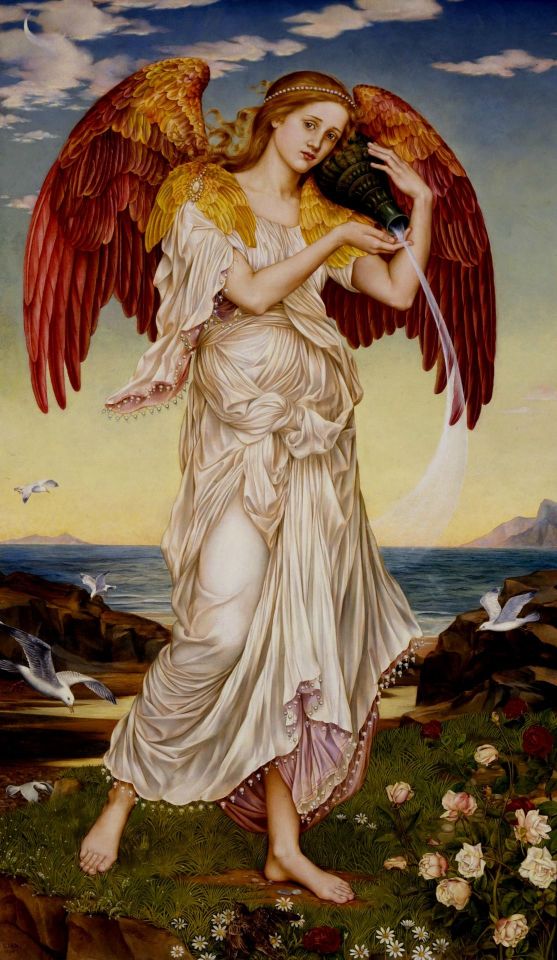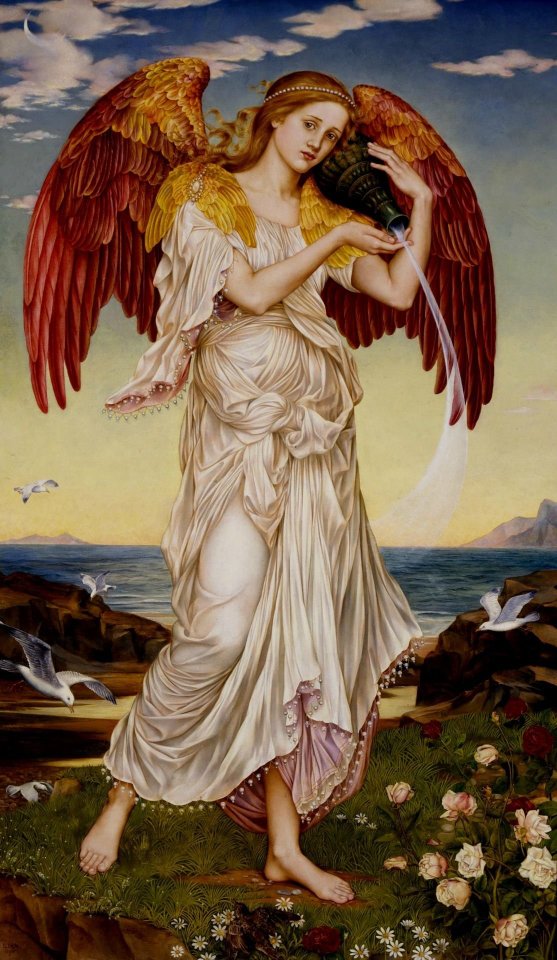#eos by evelyn de morgan: eos
Explore tagged Tumblr posts
Text

'Eos' (1895) by Evelyn De Morgan (1855–1919).
Oil on canvas.
Columbia Museum of Art.
Wikimedia.
356 notes
·
View notes
Text

Eos
Evelyn De Morgan
1895
54 notes
·
View notes
Photo

Evelyn De Morgan (English,1855-1919)
Eos, 1895
Oil on canvas
492 notes
·
View notes
Text

Evelyn de Morgan (English, 1855-1919)
Eos
276 notes
·
View notes
Text
Evelyn de Morgan, Eos, 1895

Evelyn De Morgan (30 August 1855 – 2 May 1919) was an English painter associated early in her career with the later phase of the Pre-Raphaelite Movement
18 notes
·
View notes
Text

Eos (detail)
Evelyn de Morgan
3 notes
·
View notes
Text
The Winds
Greek myth post 🎉
It all started with Astraeus and Eos.
Astraeus is a confusing figure in Greek myth, sometimes a minor deity, sometimes a giant (he probably was not a giant, for the record); according to Hesiod's Theogany, he's the son of the Titan Crius and Goddess Eurybia.
Eos is the personified Goddess of the Dawn, daughter of the sibling Titans Theia and Hyperion, children of Gaia. According to some sources, Eos was cursed by Aphrodite with an insatiable lust for mortal men. Regardless of where her lust originated, it definitely existed, and she had many lovers Eos' siblings were Helios, personified God of the Sun and Selene, personified Goddess of the Moon.
Eos and Astraeus' children were the Anemoi (the winds), and potentially a daughter, Astraea. You have Eos to thank for the stars in the night sky, too.

BOREAS - The North Wind
Eos (1895) — Evelyn De Morgan
The Anemoi
Oftentimes considered the God of winter, storms and generally just chilly weather, Boreas represents the North wind. He is strong and violent, with a quick temper.
In one myth, he takes the form of a stallion and fathers twelve colts to the mares of King Erichthonius of Dardania. Very Loki-core of him.
Boreas was said to live in Thrace. If you don't know where that is, it's north of Greece, between Turkey and northeast Greece. Because the Greeks were very intelligent and under the impression that the top of the Mediterranean was the top of the world itself, they named his home 'Hyperborea' ("Beyond the North Wind", a name that is technically accurate thanks to it's vagueness). Hyperborea was thought to be a place of bliss and peace.
Boreas is most well-known for his abduction of the Athenian Princess Orithyia, daughter of Erechtheus. Orithyia was hanging out with her ladies-in-waiting by the Ilisos River, after having rejected Boreas' advances numerous times, and (true to his temperamental nature) he abducted her.
Orithyia was later made into a Goddess of cold mountain winds. And she bore Boreas two daughters, Chione and Cleopatra, and two sons, Zetes and Calaïs. The two sons are known as the Boreads, were Giant priests of Apollo, and would later accompany the Argonauts on their journey to the Golden Fleece.
We have, unfortunately, lost Aeschylus' play Oreithyia.
Athenians considered Boreas a relative by marriage, and would pray to him in times of hardship. One story tells of Athenians praying to Boreas when threatened by Xerxes, to which he sunk 400 Persian ships to save them.

The Rape of Orithyia by Boreas (1620) — Peter Paul Rubens
ZEPHYRUS - The West Wind
The bringer of Spring and the most gentle of the four winds. Besides Boreas, Zephyrus is one of the less limited of the minor Greek deities.
Zephyrus become the consort of Iris, Goddess of the Rainbow, to whom he father Pothos, the God of Desire (Alcaeus of Mytilene writes that the couple also became parents to Eros, who is more commonly thought to be Aphrodite and Ares' son).
Zephyrus also fathered Balius and Xanthus, those two talking horses that were gifted to Achilles. Although Iris was not the mother, rather her sister, the Harpy Podarge. It is implied that this took place while he was in horse-form (I sense a recurring theme).
It has also been considered that Zephyrus fathered yet another talking horse, Arion, to a different horse-mother. Although Arion's parents are widely accepted to be Poseidon and Demeter.
It was thought by the Greeks that Zephyrus lived with his brother, Boreas. In the Odyssey, it appears that they all live with Aeolus, keeper of the winds. In the Dionysiaca, all four winds live together with their father, Astraeus.
In the Iliad, Zephyrus is visited by his wife, Iris, as he and his brothers are in his home. She wishes for him and Boreas to blow on Patroclus' funeral pyre, since Achilles prayed for their help when it failed to light.
In the myth of Eros and Psyche, Zephyrus transports Psyche to Eros'palace, and, later, reluctantly transports Psyche's sisters to visit her by Psyche's wishes.
In his most notable myth, Zephyrus falls deeply in love with the Spartan Prince, Hyacinthus, who rejected him and became a lover of Apollo instead. One day, during a game of Frisbee B.C.-Edition, Zephyrus directed Apollo's throw to his Hyacinthus' head, fatally wounding him. (In some versions of the myth, Hyacinthus' death had nothing to do with Zephyrus, and Apollo's aim is just garbage).

Zéphyr et Flore c. 1715 — Sebastiano Ricci
NOTUS - The South Wind
Though of as a wind of heat, late summer/early autumn, mist and rain, Notus, unlike his brothers, has little mythology of his own.
He has no known consorts, lovers or children, and is hardly mentioned, even in passing. However, his name shows itself in texts like the Iliad and the Odyssey.
The Bronze Age was, in mythology, brought about by a great flood incurred by Zeus after a displeasing Arcadian sacrifice. Zeus locked away the rest of the winds and set Notus loose to cause rain and flooding across the Earth, drowning almost everyone.
Notus, along with his brother, the South wind, are responsible for stranding Odysseus on Thrinacia, the island of Helios, for a solid month.
His abode is thought to be somewhere off the coast of North Africa. One interpretation suggests Aethiopeia, south of the Sahara, as the location of his palace.
Notus features in the satirical work of Dialogues of the Sea Gods by Lucian of Samosata. He and Zephyrus discuss the Argive Princess Io and her Zeus-induced plight. When Zephyrus describes the abduction of Europa with glee at having seen such a marvel, Notus quips that he is disappointed at this abduction, since it was nothing of note.
EURUS - The East Wind
Eurus is featured in myth even less so than Notus, appearing almost entirely with his other brothers at his side. Often, he is omitted from the quartet entirely.
Eurus is the only one among the four who ceases to be mentioned by Hesiod, who names "Argestes" as the fourth wind. On addition, he has no Orphic hymn in his honor (unlike the others).
Nonnus, a fifth century author from Panopolis, made Eurus one of the four winds in his Dionysiaca.
Like Notus, he has no known consorts, livers or children.
In the Pergamon Altar, depicting the Gigantomachy, Eurus is with the other winds pulling Hera's chariot.
4 notes
·
View notes
Text

Eos by Evelyn De Morgan (1895)
#evelyn de morgan#art#paintings#fine art#19th century#19th century art#pre raphaelite#pre raphaelites#painting#english artist#british artist#mythology#greek mythology#eos#dawn#goddess#classic art
2K notes
·
View notes
Text

EOS by Evelyn De Morgan (1895)
the Greek goddess Eos, goddess of the dawn and of love, standing on a seashore, surrounded by birds and flowers and pouring water from a jug.
Evelyn De Morgan was an English painter associated with the Pre-Raphaelite Movement. Her paintings are figural, foregrounding the female body through the use of spiritual, mythological, and allegorical themes. They rely on a range of metaphors (such as light and darkness, transformation, and bondage) to express what several scholars have identified as spiritualist and feminist content.
Eos is exhibited in the Columbia Museum of Art, Columbia, South Carolina
83 notes
·
View notes
Photo

Evelyn de Morgan Eos 1855
44 notes
·
View notes
Photo

‘Eos’ (1895) by Evelyn De Morgan (1855–1919).
Oil on canvas.
Columbus Museum of Art
Wikimedia.
114 notes
·
View notes
Photo

Eos by Evelyn De Morgan (1895)
Personification of the Dawn
15 notes
·
View notes
Text

Eos est la déesse titan grecque de l'aube qui était honorée à la naissance de chaque nouveau jour. En plus d'être la personnification de l'aube, elle représente également la jeunesse, l'espoir, l'éveil et les nouveaux départs.
'Eos'- Evelyn De Morgan, 1895.
3 notes
·
View notes
Photo

“Eos” (Aurora, Goddess of the Dawn) by Evelyn De Morgan (1895).
46 notes
·
View notes

